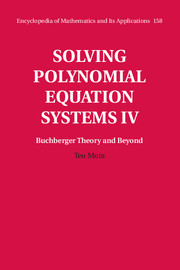50 - Spear 2
from PART SEVEN - Beyond
Published online by Cambridge University Press: 05 April 2016
Summary
Buchberger theory and algorithm, which were stated for polynomial rings over a field, were earlier extended essentially in two different directions: on one hand relaxing the assumption on the coefficients, allowing to deal with, at least, an effective principal ideal ring; on the other hand dropping commutativity of the variables.
This allowed me, based on the lifting theorem presentation put forward by Möller and Pritchard, to introduce both Buchberger theory and algorithm in the generic setting of a monoid ring R[S] provided that both the ring R and the monoid S are sufficiently effective.
Actually, the Möller–Pritchard formulation of Buchberger theory can also be easily applied to cover Kandri-Rody–Weispfenning's solvable polynomial rings and even to relax the restriction requiring that variables and coefficients commute, covering at least multivariate Ore extensions.
This is not sufficient to cover other important settings on which a Buchberger theory and algorithm have been provided: on one hand the extension to group rings and path algebras, which requires the notion and tool of saturation and which has been formalized and settled by Birgit Reinert under the concept of function rings; on the other hand the rings introduced by Tamari and tested by V. Weispfenning, the researcher who strongly forced and extended the limits of Buchberger's theory. In both cases, as we have seen, their solution can be reformulated via Spear's Theorem.
Spear's theorem states that, given a quotient ring A = Q/I of a ring Q which has a Buchberger theory, the projection Π : Q ↠ A and an ideal J ⊂ A and denoting J ′ := Π−1(J) = J + I and F a Gröbner basis of J′, then a Gröbner basis of J′ can be easily extracted from Π(F). We must specify from the beginning that this cannot be considered as an approach for computing Gröbner bases, if for no other reason than the obvious Noetherianity problem, but also as a central tool, together with the Zacharias–Szekeres results, for developing a Buchberger theory and algorithm for an effectively given ring along the footpath established by the Möller–Pritchard formulation.
- Type
- Chapter
- Information
- Solving Polynomial Equation Systems IV , pp. 335 - 422Publisher: Cambridge University PressPrint publication year: 2016



